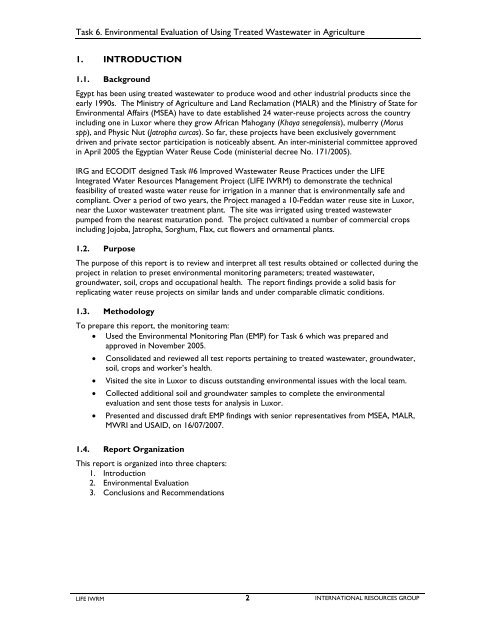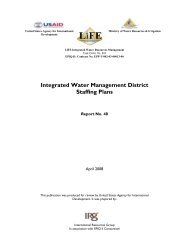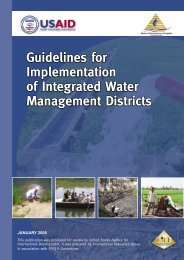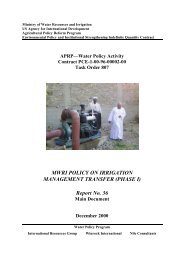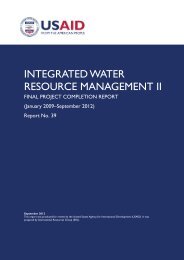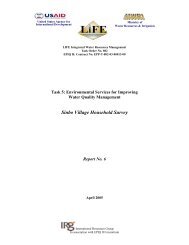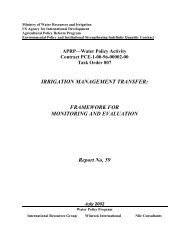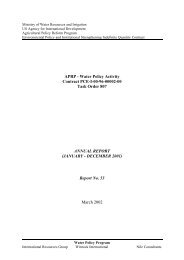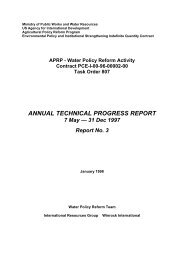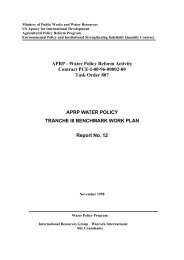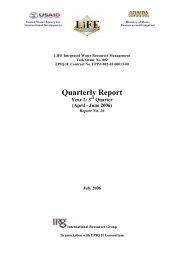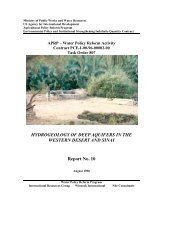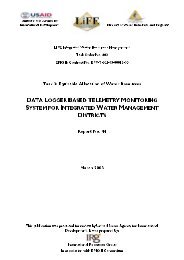Report 45 Task 6 Environmental Evaluation Luxor Demo Site
Report 45 Task 6 Environmental Evaluation Luxor Demo Site
Report 45 Task 6 Environmental Evaluation Luxor Demo Site
You also want an ePaper? Increase the reach of your titles
YUMPU automatically turns print PDFs into web optimized ePapers that Google loves.
<strong>Task</strong> 6. <strong>Environmental</strong> <strong>Evaluation</strong> of Using Treated Wastewater in Agriculture<br />
1. INTRODUCTION<br />
1.1. Background<br />
Egypt has been using treated wastewater to produce wood and other industrial products since the<br />
early 1990s. The Ministry of Agriculture and Land Reclamation (MALR) and the Ministry of State for<br />
<strong>Environmental</strong> Affairs (MSEA) have to date established 24 water-reuse projects across the country<br />
including one in <strong>Luxor</strong> where they grow African Mahogany (Khaya senegalensis), mulberry (Morus<br />
spp), and Physic Nut (Jatropha curcas). So far, these projects have been exclusively government<br />
driven and private sector participation is noticeably absent. An inter-ministerial committee approved<br />
in April 2005 the Egyptian Water Reuse Code (ministerial decree No. 171/2005).<br />
IRG and ECODIT designed <strong>Task</strong> #6 Improved Wastewater Reuse Practices under the LIFE<br />
Integrated Water Resources Management Project (LIFE IWRM) to demonstrate the technical<br />
feasibility of treated waste water reuse for irrigation in a manner that is environmentally safe and<br />
compliant. Over a period of two years, the Project managed a 10-Feddan water reuse site in <strong>Luxor</strong>,<br />
near the <strong>Luxor</strong> wastewater treatment plant. The site was irrigated using treated wastewater<br />
pumped from the nearest maturation pond. The project cultivated a number of commercial crops<br />
including Jojoba, Jatropha, Sorghum, Flax, cut flowers and ornamental plants.<br />
1.2. Purpose<br />
The purpose of this report is to review and interpret all test results obtained or collected during the<br />
project in relation to preset environmental monitoring parameters; treated wastewater,<br />
groundwater, soil, crops and occupational health. The report findings provide a solid basis for<br />
replicating water reuse projects on similar lands and under comparable climatic conditions.<br />
1.3. Methodology<br />
To prepare this report, the monitoring team:<br />
• Used the <strong>Environmental</strong> Monitoring Plan (EMP) for <strong>Task</strong> 6 which was prepared and<br />
approved in November 2005.<br />
• Consolidated and reviewed all test reports pertaining to treated wastewater, groundwater,<br />
soil, crops and worker’s health.<br />
• Visited the site in <strong>Luxor</strong> to discuss outstanding environmental issues with the local team.<br />
• Collected additional soil and groundwater samples to complete the environmental<br />
evaluation and sent those tests for analysis in <strong>Luxor</strong>.<br />
• Presented and discussed draft EMP findings with senior representatives from MSEA, MALR,<br />
MWRI and USAID, on 16/07/2007.<br />
1.4. <strong>Report</strong> Organization<br />
This report is organized into three chapters:<br />
1. Introduction<br />
2. <strong>Environmental</strong> <strong>Evaluation</strong><br />
3. Conclusions and Recommendations<br />
LIFE IWRM 2<br />
INTERNATIONAL RESOURCES GROUP


